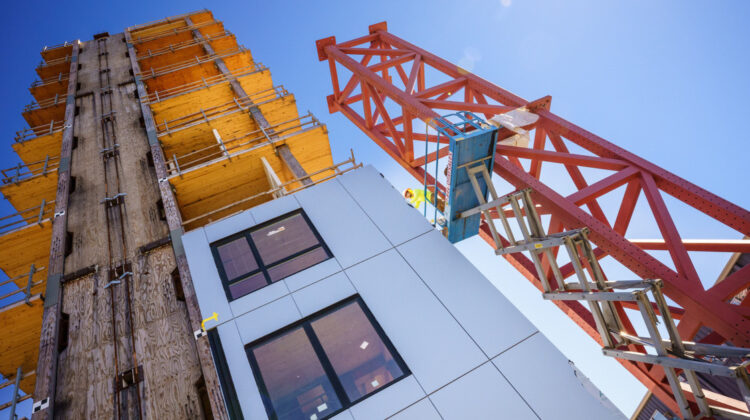
Practical testing is underway at the University of California San Diego (UCSD) on a ten-storey building made of cross-laminated timber, the tallest full-scale building ever to be constructed and tested on an earthquake simulator, or shake table.
The shake table will simulate earthquake motions recorded during prior earthquakes covering a range of earthquake magnitudes from magnitude 4 to magnitude 8 on the Richter scale. This will be done by accelerating the table to at least 1g, which could accelerate the top of the building to as much as 3gs (modern rollercoasters produce 4g of peak acceleration).
Buildings made of mass timber – layers of wood bonded together – are gaining popularity as greener, faster alternatives to concrete-and-steel structures. With new building codes in the USA recently updated to permit more high-rise mass-timber buildings to be constructed, many have questioned how such buildings would fare in earthquakes.
‘Mass timber is part of a massive trend in architecture and construction, but the seismic performance of tall buildings made with these new systems is not as well understood as other existing building systems,’ said Shiling Pei, an associate professor of civil and environmental engineering at Colorado School of Mines.
The ten-storey Tallwood building was built at full-scale and is roughly 35 metres tall. In addition to testing the building, researchers will gauge the performance of several non-structural components, including a three-storey glass facade.
Pei’s team, which includes both researchers and practitioners, designed a mass timber rocking wall lateral system suitable for regions with high earthquake hazard. This new system is aimed at resilient performance, which means the building will have minimal damage from design-level earthquakes and be quickly repairable after rare earthquakes.
‘The rocking wall system basically consists of a solid wood wall panel anchored to the ground using steel cables or rods with large tension forces in them,’ Pei said. ‘When exposed to lateral forces, the wood wall panels will rock back and forth – which reduces earthquake impacts – and then the steel rods will pull the building back to plumb once the earthquake passes.’
Due to the seismic movement induced by the rocking system, resilience-critical non-structural components within and covering the building, such as the exterior facade, interior walls and stairways, are in for a big ride.
‘Resilient design must also account for the building’s non-structural systems, which are not part of the structural load-resisting system, but play an important role in the building’s function and its ability to recover after the earthquake,’ said Keri Ryan, an engineering professor at the University of Nevada, Reno.
The project team led by Ryan will focus on safety-critical non-structural components that span floor-to-floor and are thus subjected to the relative movement between storeys. The building features four exterior façade assemblies, a number of interior walls, and a ten-storey stair tower. The performance of the stairs will be assessed by a team led by Professor Tara Hutchinson from the UC San Diego Department of Structural Engineering.
The exterior envelope must protect the building from temperature extremes and weather events, while stairs must remain functional to allow occupants to safely exit and first responders to continually reach all floors of the building. ‘These assemblies have been designed with a variety of new and innovative details that are intended to accommodate the floor-to-floor movement without damage,’ Ryan said. ‘Many of these details have never been tested in a rigorous building setting.’
In 2017, Pei’s team carried out a test on a two-storey mass timber building by simulating shaking from the Northridge Earthquake, a magnitude 6.7 earthquake that struck Los Angeles in 1994. The building was subjected to 13 earthquake tests and remained structurally damage-free. In addition to demonstrating that mass timber building systems can be seismically resilient, those tests helped the research team develop the design and analysis methods that have been used for the ten-storey building.


